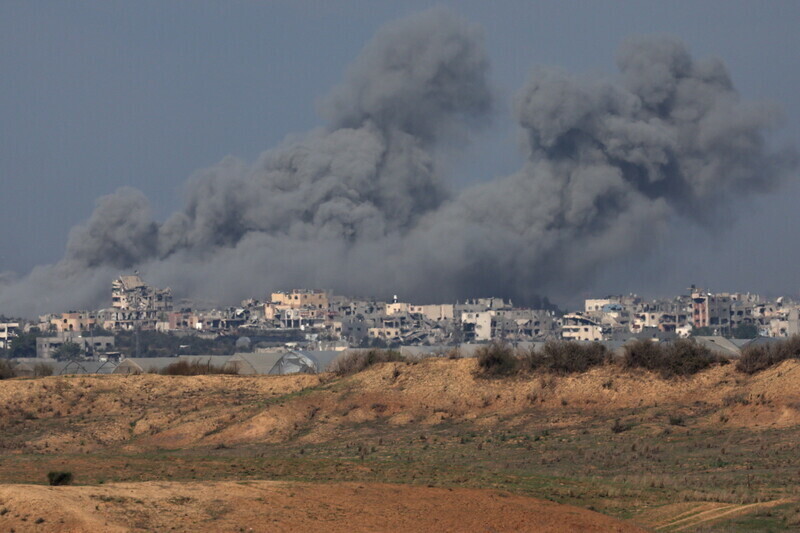hankyoreh
Links to other country sites 다른 나라 사이트 링크
[Guest essay] Seeing Jeju in Gaza


By John Eperjesi, professor of literature at Kyung Hee University
One of the worst civilian massacres in 20th-century Asian history took place on Jeju Island at the dawn of the Cold War. On this “hauntingly beautiful island,” Bruce Cumings writes, “the postwar world first witnessed the American capacity for unrestrained violence against indigenous peoples fighting for self-determination and social justice.”
Over the past two months, a civilian massacre on the other side of Asia, in Gaza, has been unfolding, one that many scholars, journalists, and activists are calling a genocide. This humanitarian crisis can be compared to the Jeju April 3 Incident because Palestinians in Gaza have also been fighting for self-determination and justice, and against an Israeli military occupation, since 1967. We can see Jeju’s past in the unrestrained violence raining down on Gaza now.
The US military occupation of South Korea began in 1945 when the World War II defeat of Japan ended 35 years of colonial rule in Korea. Frustration and anger at the military occupation built up slowly at first, then accelerated and exploded three years later on Jeju Island. John Merrill points out that “violent opposition on this scale to a postwar American occupation occurred nowhere else in Asia or Europe.”
Like Jeju Islanders at the inception of the Cold War, over the past 56 years, Palestinians in occupied Gaza have been routinely subjected to multiple forms of state violence designed to terrorize them into submission: beatings, torture, executions, interrogations, curfews, deportations, property destruction, financial sanctions, blockades and indiscriminate bombings. In 1987, 20 years after the Israeli military occupation of Gaza and the West Bank began, the first Palestinian uprising, or “intifada,” occurred. This was a mostly nonviolent uprising, led mainly by women and inspired in part by Mahatma Gandhi, Martin Luther King and Gene Sharp.
Just as the entire population of Gaza is being punished for the Oct. 7 attack by Hamas militants, the entire population of Jeju was subjected to state terror after the April 3 uprising. The US military government and the newly formed Republic of Korea administered “collective punishment” on the entire island, a war crime prohibited by the Hague Regulations (1899) and the Fourth Geneva Convention (1949). Between 1948 and 1954, an estimated 25,000 to 30,000 Jeju islanders were killed, or one-tenth of the population. Nearly every family on Jeju was impacted by the violence.
Over the past two months, over 18,000 Palestinians have been killed and close to 50,000 have been injured, with 7,780 missing. Every family in Gaza has been impacted by the violence. In Jeju, one-third of the victims were elderly, women, or children. In Gaza, 70% of those killed have been women and children under the age of 18. At least 7,729 children have been killed.
In Jeju, scorched-earth campaigns destroyed 95 percent of mountain villages, and 80,000 to 90,000 villagers were forcibly relocated to internment camps along the coastline. Corey Scher of New York’s CUNY Graduate Center and Jamon Van Den Hoek of Oregon State University “found that almost 900,000 buildings across Gaza have suffered severe destruction and damage from Israeli bombardments, including places of worship, hospitals, schools, and residential buildings.” The UN estimates 80 to 90% of the population of Gaza is internally displaced. According to the UN World Food Programme, Palestinians who have been forced out of their homes are now stuck in overcrowded shelters, makeshift tents, and open areas without enough food, clean water, proper sewage or sanitation. More people may end up dying from diseases — bloody diarrhea, jaundice, measles, meningitis, chickenpox, viral hepatitis — than from bombs and missiles.

Israeli Defense Minister Yoav Gallant stated, “I have ordered a complete siege on the Gaza Strip. There will be no electricity, no food, no fuel, everything is closed. We are fighting human animals, and we act accordingly.” Israel’s Deputy Mayor of Jerusalem Arieh King said, “They are not human beings, and they are not animals, they are subhuman and that is how they should be treated.” Asian peoples, from Palestine in the west to Korea in the east, have often been subjected to dehumanizing stereotypes and slurs. In the United States, derogatory terms like “yellow peril,” “gook,” “sand nigger,” “raghead,” “chink,” “Jap,” “Nip,” “slope,” and most recently “China virus,” have historically enabled acts of racist hate, both big and small, both foreign and domestic, ranging from the massacre of civilians in the Philippines, Japan, Korea, Vietnam, and Iraq, to the brutal attacks on Asian Americans during the pandemic which gave rise to the #StopAsianHate movement.
Isaac Herzog, the president of Israel, views the murder of civilians and destruction of Gaza as part of a global clash of civilizations. “This is a war that is not only between Israel and Hamas. It’s a war that is really intended, really, truly, to save Western civilization,” Herzog has said. The state of Israel, propped up with billions of dollars in military aid from the US, is broadcasting the interrelated practices of racism, apartheid, settler colonialism, ethnic cleansing and genocide that helped build Western civilization, and viewers from around the world are horrified by what they are seeing.
Many are dusting off their copies of Edward Said’s “Orientalism” (1978) to make sense of what is happening in Gaza. An equally relevant text, I would suggest, is “Discourse on Colonialism” (1950) by the great Martinican poet, playwright, and politician Aimé Césaire. When the US was the only country to veto the UN Security Council resolution demanding an immediate humanitarian ceasefire in Gaza, I thought of Césaire’s words: “I make no secret of my opinion that at the present time the barbarism of Western Europe has reached an incredibly high level, being only surpassed — far surpassed, it is true — by the barbarism of the United States.” A barbaric form of American exceptionalism is thriving in the 21st century.
The horrific attack by Hamas militants on Oct.7 killed 1,200 Israelis, and their deaths should be mourned along with Palestinians. Massive protests around the world are calling for a ceasefire to stop the violence. In the US, many of these protests are being led by Jewish groups and their allies.
In 1953, the Armistice Agreement stopped the senseless killing of the Korean War, but the ceasefire was never followed up by a formal peace treaty. Unending war has resulted in massive military buildup, divided families, authoritarian governments, travel restrictions, sanctions, famine, and mandatory military service. Everyone on the Korean Peninsula, and indeed in the Asia-Pacific region, lives under the threat of a return to total war. There are plenty of hawks in the United States who would love to do to North Korea, and China, what Israel is doing to Gaza.
If the new cold war turns hot, the entire Korean Peninsula, both North and South, will be reduced to rubble while American bombers fly overhead, emblazoned with the slogan, “Saving Western Civilization.”
Please direct questions or comments to [english@hani.co.kr]
Editorial・opinion
![[Column] Will Seoul’s ties with Moscow really recover on their own? [Column] Will Seoul’s ties with Moscow really recover on their own?](https://flexible.img.hani.co.kr/flexible/normal/500/300/imgdb/original/2024/0513/5917155871573919.jpg) [Column] Will Seoul’s ties with Moscow really recover on their own?
[Column] Will Seoul’s ties with Moscow really recover on their own?![[Column] Samsung’s ‘lost decade’ and Lee Jae-yong’s mismatched chopsticks [Column] Samsung’s ‘lost decade’ and Lee Jae-yong’s mismatched chopsticks](https://flexible.img.hani.co.kr/flexible/normal/500/300/imgdb/original/2024/0512/3017154788490114.jpg) [Column] Samsung’s ‘lost decade’ and Lee Jae-yong’s mismatched chopsticks
[Column] Samsung’s ‘lost decade’ and Lee Jae-yong’s mismatched chopsticks- [Correspondent’s column] The real reason the US is worried about Chinese ‘overcapacity’
- [Editorial] Yoon’s gesture at communication only highlights his reluctance to change
- [Editorial] Perilous stakes of Trump’s rhetoric around US troop pullout from Korea
- [Guest essay] Preventing Korean Peninsula from becoming front line of new cold war
- [Column] The state is back — but is it in business?
- [Column] Life on our Trisolaris
- [Editorial] Penalties for airing allegations against Korea’s first lady endanger free press
- [Editorial] Yoon must halt procurement of SM-3 interceptor missiles
Most viewed articles
- 1Seoul’s plan to adopt SM-3 missiles is like wanting a sledgehammer to catch a fly
- 2[Column] Samsung’s ‘lost decade’ and Lee Jae-yong’s mismatched chopsticks
- 3[Correspondent’s column] The real reason the US is worried about Chinese ‘overcapacity’
- 4Korea poised to overtake Taiwan as world’s No. 2 chip producer by 2032
- 560% of young Koreans see no need to have kids after marriage
- 6[Editorial] Yoon’s gesture at communication only highlights his reluctance to change
- 7Yoon voices ‘trust’ in Japanese counterpart, says alliance with US won’t change
- 8Yoon rejects calls for special counsel probes into Marine’s death, first lady in long-awaited presse
- 9S.K.-Japan joint history project to be revived
- 10Former President Roh Tae-woo, mastermind of 1979 military coup, dies at 88